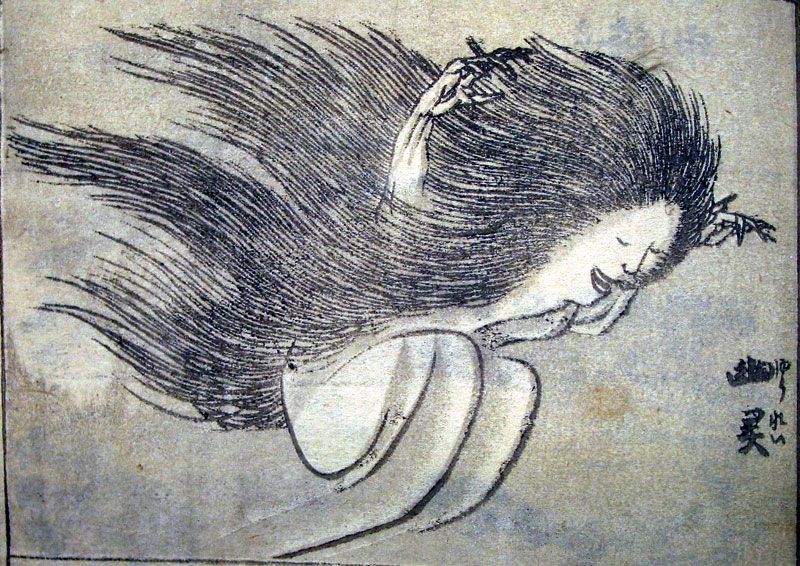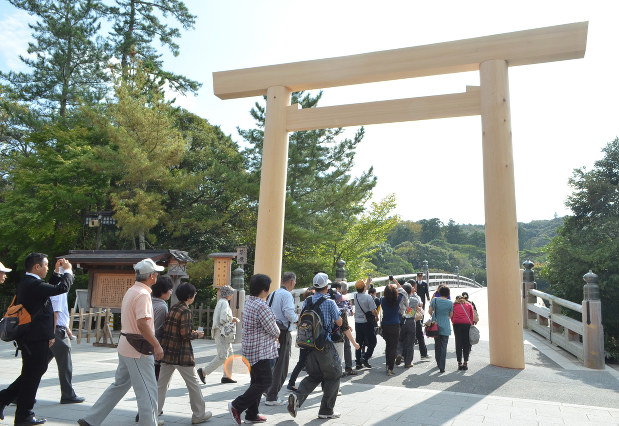Tales of Ghostly Japan
By Zack Davisson
昔In the summertime of old Japan, when the oppressive heat and humidity rendered daylight activity all but unbearable, people longed for the night and the scant relief brought by the setting sun. There, amidst a chorus of frogs and insects serenading the coming Obon, the people would play Hyakumonogatari Kaidankai (百物語怪談会), or A Gathering of 100 Ghostly Tales, and silently the spirits would return.
100 candles would be placed in a circle, and the players would each tell a ghoulish tale, often a story from their local village, or perhaps a more personal experience. As each tale ended, the storyteller would douse a single candle, the light slowly fading as the tension rose. The game was said to be a ritual of evocation, the expiration of each story and each candle summoning more spiritual energy, transforming the room into a beacon for the dead. With the vanishing of the final light, someone or something terrible would be waiting in the darkness.
We haven’t the space to play a full game of Hyakumonogatari Kaidankai, but perhaps, reading all these stories together, we can summon up enough ghostly substance to call forth an apparition to keep us company through the night. With that in mind, let the sun sink behind the mountains, cut the electricity, and light exactly four candles – the Japanese number for death, one for each tale of ghostly Japan.
Under the Peony Lantern – A Cautionary Tale of Sex with the Dead
Long ago, on the first night of Obon, a widowed samurai named Ogiwara Shinnojo sat on his porch, watching the day fade into night. To his surprise, a beautiful young woman and her maid, who was carrying a lantern emblazoned with a peony, walked near. The pair paused to speak with Ogiwara, and he found the young woman’s name to be Otsuyu. An instant attachment was formed, and Otsuyu promised to return the following night, at the same time.
From that night onward, always at dusk, she would arrive with her maid, carrying the same Peony Lantern. Ogiwara and Otsuyu rapidly progressed in their affair, and she took to sleeping with him, always leaving before dawn. This relationship continued for some time, and both were happy.
However, a suspicious neighbor, wondering at Ogiwara’s new habit of staying awake all night and sleeping the day away, hid outside his house, peeking through a small hole in the wooden wall in order to observe the old man’s nighttime shenanigans. Much to his surprise, he uncovered the widowed samurai passionately entwined with a skeleton, packing only scarce, clinging bits of rotting flesh and cobweb-infested long black hair. Half-mad, the neighbor fled screaming from the scene.
The next day he confronted Ogiwara, bringing with him a Buddhist priest who warned of the danger facing his soul. One cannot dally with the dead. Ogiwara took this to heart, and vowed to free himself from the spell of Otsuyu. With the priest’s help, he surrounded his house with ofuda, strips of paper upon which are written Buddhist sutras, offering protection from the supernatural. That night, Otsuyu and her maid came as always, but they cried at the steps of his porch, unable to enter the house.
Night after night she returned, begging Ogiwara to remove the ofuda so that they may be lovers again. Slowly, the lonely old man’s resistance slipped away, and one night he left his house to join his beloved.
The next morning, he was nowhere to be found. His friends looked far and wide, until the neighbor suggested they search the cemetery. At long last, they found the graves of Otsuyu and her maid, emblazoned with the same peony pattern. Opening the crypts, no one was surprised to see the corpse of Ogiwara, still passionately entwined with his skeletal lover.
So they say.
With this tale told, wet your fingers and pinch out the fire of the first candle.
The Kiss of the Kuchisake-onna
One night, not so long ago, salaryman Taro was flushed with sake and success, having closed a deal that ensured money for his company and promotion for himself. In celebration, he had been drinking with his co-workers, and had more than his usual share.
In the bar, there was also a woman sitting alone. She was elegant and beautiful, with captivating eyes and glimmering black hair. Not unusually for the season, she wore a surgical mask that covered her lower face, as a protection from the various pollens and pollutions that tainted the air.
Salaryman Taro, feeling braver than usual, sat next to the woman and talked away at her, buying her a drink which she never touched and boasting of his success and promising future. She answered demurely but interested, and he suggested that they move to a more private bar that he knew, not so far away. She nodded, and with a wink to his co-workers the two moved out into the street.
Taro was quick to hurry her to a nearby, darkened alley, where he pulled her close and stared into her enchanting eyes. “Am I beautiful?” the woman asked, in a quivering voice, muffled behind the surgical mask. “Very beautiful,” he replied, moving his face closer. “Am I beautiful?” she repeated, reaching behind her head to undo the barrier between their mouths. “Most beautiful.” he said again, anticipating the kiss that was his.
The mask slipped from her face and Taro froze, unable even to scream. The woman’s mouth spread from one ear to the other, consuming her lower face. From the nose down, it was split, with two flaps of skin spreading to show her rows of sharp pointed teeth. Her hinged jaw opened impossibly wide, and her misshapen mouth somehow managed to form the words again: “Am I beautiful?”
Salaryman Taro, aged 30, was never heard of again.
So they say.
Another candle goes out, and the shadows around your home begin to resemble a long, gaping smile…
The Evil Split of Princess Sakura – A Tale of Passionate Karma
Long, long ago, there was a Buddhist monk who was in love with a princess. The object of his affections, Sakura, was young and beautiful, but she had been sent to the monastery as a nun due to a crippling deformity that kept her right hand closed in a permanent fist. Being so deformed, it was thought that she could never be married. The monk, Seigen, pursued her, and to everyone’s amazement was able to open her fused fist, revealing a small incense box that had been hidden in her hand since birth.
Seigen alone was not surprised, instantly recognizing the elegant and detailed box. It had belonged to his lover, a young man who, agonized at the cruel laws of gender that prevented them from marrying, committed suicide years earlier. His dying vow was to be born again as a woman so that he could be a proper wife to Seigen. The Princess Sakura was Seigen’s lover reborn.
Repulsed at this tale, she fled from the monastery, from her karma, from Seigen, and into the waiting arms of her lover, a thief and rogue named Gonosuke. Seigen pursued her, but was no match for Gonosuke who quickly skewered him on his sword. Free to do as he will, the dastardly cad made a fast profit selling the unfortunate princess into prostitution.
But it didn’t end there. The wraith of Seigen rose as an onryo, a deadly spirit consumed by vengeance. Sakura knew not another peaceful night, as the setting of the sun was swiftly followed by the rising of Seigen. “Cursed you are!” he screamed at her. “You have betrayed your karma, betrayed a promise made by your past self, betrayed a love that was ordained by fate.” Sakura knew it was true and, after enduring much torment, decided to make amends.
First, she smothered the small child sleeping next to her – her own, an illegitimate byproduct of Gonosuke’s lust. Next, she escaped the brothel and traveled the long road to Gonosuke’s home. There, finding him asleep, she plunged a sword into his body repeatedly, while Seigen’s ghost looked on approvingly. As a last act of contrition, she closed her hand again around the incense box, so delicately and intimately carved, and sheathed the sword in her own neck.
So they say.
One more candle, leaving only a single light source. The dark room is thick with tension, as you steel yourself for the final tale.
True Tales of Tokyo Terror Taxis
The cabdriver knew that the ghosts of Japan were not confined to ancient graveyards and shadow-haunted shrines. Any modern resident of the nation’s capital could tell you that the taxis of Tokyo are more haunted than hearses, and his own route took him regularly through open gates to the spirit world. There was Sendagaya tunnel, which winds beneath the cemetery of Senjuiin Temple, or Shirogane tunnel, where legend has it that screaming faces are silhouetted against the tunnel’s pillars and through which the Shinigami – the spirit of Death itself – is said to pass. All of his fellow cabbies could wax a yarn of passengers who got on then disappeared, or of catching a glimpse of a woman or child’s face in the rear view mirror. He too had a story to tell.
It was a stormy autumn night, near Aoyama Cemetery, where he picked up a poor young girl drenched by the rain. It was dark, so he didn’t get a good look at her face, but she seemed sad and he figured she had been visiting a recently deceased relative or friend. The address she gave was some distance away, and they drove in silence. A good cabbie doesn’t make small talk when picking someone up from a cemetery.
When they arrived at the address, the girl didn’t get out, but whispered for him to wait a bit, while she stared out the window at a 2nd floor apartment. Ten minutes or so passed as she watched, never speaking, never crying; simply observing a solitary figure move about the apartment. Suddenly, the girl asked to be taken to a new address, this one back near the cemetery where he had first picked her up. The rain was heavy, and the driver focused on the road, leaving the girl to her thoughts.
When he arrived at the new address, a modern house in a good neighborhood, the cabbie opened the door and turned around to collect his fare. To his surprise, he found himself staring at an empty back seat, with a deep puddle where the girl had been sitting moments before. Mouth open, he just sat there staring at the vacant seat, until a knocking on the window shook him from his reverie.
The father of the house, seeing the taxi outside, had calmly walked out bringing with him the exact change for the fare. He explained that the young girl had been his daughter, who died in a traffic accident some years ago and was buried in Aoyama Cemetery. From time to time, he said, she hailed a cab and, after visiting her old boyfriend’s apartment, asked to be driven home. The father thanked the driver for his troubles, and sent him on his way.
So they say.
Now, before we put out the final candle, a word of warning…
The Rule of the Dead
Perchance, with the extinguishing of your final candle, you should find that the evocation of Hyakumonogatari Kaidankai has worked its magic, and a yurei has taken an interest in you and settled in your house. A word of caution: fear the dead, but most of all, respect them.
In Japan, the dead can be dangerous, and make demands on the living. These demands must be met with the utmost care. It is said: “To ignore tradition is foolhardy; to anger the dead by not providing for them tempts fate; to be in a place where others have died subjects you to forces beyond your control. Avoidance, care, ritual, respect, tradition. These are your bywords.”
Keep this in mind as you wet your fingers one last time, to protect them against the burning fire of the solitary candle illuminating this story. Keep your mind clear and your soul calm, ready to face that which is revealed by the encroaching darkness. Avoidance, care, ritual, respect, tradition.
Now, reach forward…
Obake, Yurei, and Onryo. Oh my!
Phantom, Ghost, Spirit, Spook, Apparition, Specter – the English language is ripe with designations for the remaining essence of the departed, both original words and those borrowed from other languages. Japanese is the same, with each name connoting a different style of nightly visitor.





